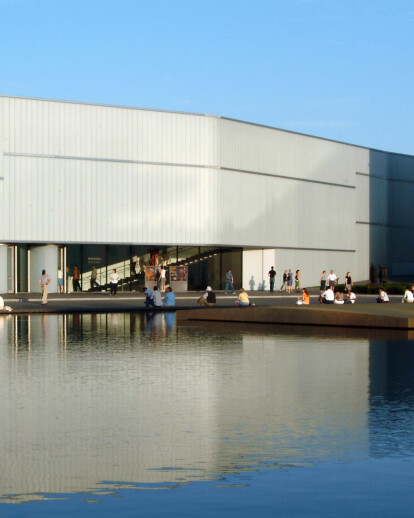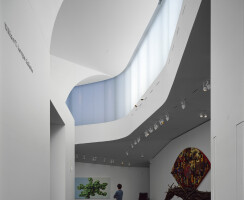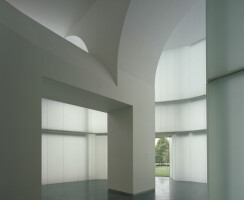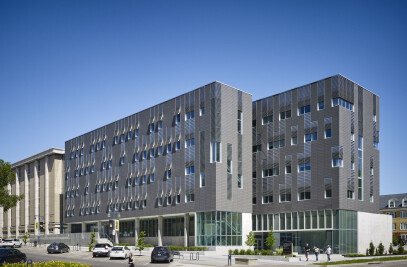Bloch Building
BNIM was selected to serve as Architect of Record with Design Architect Steven Holl of New York City on a major expansion to the Nelson-Atkins Museum of Art. As Architect of Record, BNIM was responsible for all aspects of design support, project management and construction administration.
The expansion comprises the first major addition to the Beaux-Arts style structure since it opened in 1933. The new addition provides 150,000 sf of new galleries and public facilities including an entry lobby, art library, cafe and sculpture court devoted to the works of Isamu Noguchi. Holl’s design features five striking glass “lenses” rising from the rolling terrain on the east side of the Museum. These lenses house new gallery space under specially contoured ceilings that respond to the undulating landscape outside. The lenses diffuse natural light into the art galleries below, and at night the galleries softly glow from within. Moving through the addition, visitors experience a flow between light, art, architecture and landscape, with views from one level to another, from inside to outside.
Entry Plaza and Parking Structure
The new main entry plaza for the Nelson-Atkins Museum of Art features a reflecting pool with an installation entitled “One Sun/34 Moons” by Walter De Maria. A 30-by-40 foot bronze and steel slab coated with gold leaf slab rises above the 160-by-140 foot reflecting pool containing 34 glass “oculi” designed by Steven Holl to allow light to enter the two-level below-grade parking garage.
The parking garage accommodates 450 cars and features a specially formed “wave tees” ceiling of pre-cast and rest and place concrete. The structure provides connections to the surrounding sculpture garden and addition space to the existing museum, including an underground entry to the plaza courtyard. This project was designed in collaboration with Steven Holl Architects.
Bloch Impressionist Galleries
The Bloch Impressionist Galleries is one of several renovation projects completed by BNIM at the Nelson-Atkins Museum of Art, beginning in 2000. Like those preceding it, this renovation involves significant alterations to architectural finishes throughout the spaces and large-scale upgrades to the mechanical, electrical, and life-safety systems within the confines of the galleries.
The galleries occupy approximately 10,000 sf located on the plaza level and encompasses the entire northeast quadrant of the building. The mechanical unit and associate ductwork serving these areas will be replaced, incorporating crucial life-safety and environmental sensors to protect both visitors and the precious artwork.
Once complete, the Bloch Impressionist Galleries will showcase the internationally celebrated Marion and Henry Bloch Collection of Impressionist and Post-Impressionist Art, which was amassed over a 20-year period.
Egyptian Galleries | Susan B. and Mark A. Susz Galleries
The Egyptian Gallery, part of the Susan B. and Mark A. Susz Galleries at the Nelson-Atkins Museum of Art, provides a permanent home for the exquisite funerary objects of the Ancient Egyptian noblewoman Meretites. The gilt sarcophagus of Meretites stands upright drawing visitors into a gallery space that is calm, reflective and reverent to the nature of the collection. In addition to a complete renovation of architectural finishes, lighting and new casework, the scope of work also included comprehensive life safety and mechanical system upgrades. The exterior walls of the Nelson-Atkins Building, which define the galleries, were bolstered with new insulation and a moisture barrier, helping to preserve the collection and improve the performance of the Museum’s operations.
The design of new Egyptian Gallery features clean, modern details, which place emphasis on the collection itself. The walls are finished in a dark colored Venetian plaster; an antique bronze detail articulates the extents of the plaster wall, framing both stone trim and glass casework.
American Indian Gallery
The American Indian Art Galleries bring to fruition the Museum’s long-standing efforts to illuminate the importance of Native artistic traditions, and the significant role these traditions have played in the development of our nation’s cultural identity. The collection is arranged by origin according to seven geographic areas: Woodlands, Plains, Southwest, Plateau, California and the adjacent Great Basin, Northwest and Arctic.
The design of the American Indian Art Galleries represents a departure from the neo-classical details of the original Nelson-Atkins Building; the new galleries are devoid of ornament, replaced by clean, modern details, which place emphasis on the collection itself. While the color palette is restrained, the materials specified throughout the space exude richness and depth.
Similar to work completed on the Egyptian Gallery, BNIM’s scope of work included life safety and mechanical system upgrades, plus new insulation and a moisture barrier for the exterior walls of the Nelson-Atkins Museum.
American Art Gallery | Sarah and Landon Rowland Galleries
The creation of the Sarah and Landon Rowland American Art Galleries at the Nelson-Atkins Museum of Art serves as a testament to the renewed value of American Art and demonstrates the importance these works have in the preservation and promotion of our collective history. The galleries feature work from a unique period in American Art history and are arranged in chronological order. They culminate in the collection’s grand exhibit space, Rowland Hall.
Designed in the Adam Style, Rowland Hall features ornate molding and an elaborate vaulted plaster ceiling illuminated by two-glass oculi. On the opposite end of the linear sequence of galleries is the Rotunda, an existing “nodal” gallery of its own significance.
The Drawing and Print Corridor and Antechamber, which connect Rowland Hall to the original Rotunda, have also been completely renovated. New painting galleries have been created and feature modernized laylite glass ceilings, in response to the original glass ceiling installation found in typical galleries throughout the Museum.
Ford Learning Center + Signage
BNIM designed the Ford Learning Center as part of the overall renovation of the Nelson-Atkins Museum of Art. It serves as the center of all the Museum’s education and outreach programs. The space, which triples the existing area devoted to educational programs, includes an Educator Resource Center; an Orientation/Training classroom offering state-of-the-art technology and training resources; a gallery wall exhibiting art by children and adults who participate in the center’s programs; classrooms; and support office spaces.
Large-scale super graphics, visible from the Museum’s main circulation spine, alert visitors to the presence of the Center and invite them inside. Once inside, the design is youthful, yet sophisticated. A neutral palette allows the artwork to take center stage. Color is accented at each of the seven classrooms where the signage and entrance design have been developed to provide a cheerful wayfinding system appealing to both children and adults.
Administrative Office Renovations
The lower level of the original Nelson-Atkins Building was renovated to provide administrative office space for the Museum’s curatorial, human resources, and finance departments. The renovation fulfills a significant part of the Museum’s Long-Term Master Plan to vacate leased office space and locate all employees on the Museum campus. The program included private and open offices, conference space, workrooms, and break areas. The renovation involved significant alterations to architectural finishes, as well as the removal of existing combustible materials and large-scale upgrades to the mechanical, electrical and life safety systems.
BNIM’s design for the new office space left the existing structural system and infrastructure exposed intermittently, and contrasted with highly finished areas of rich materials and bold accent colors. Due to the subterranean nature of the space, the quality of artificial lighting was paramount. The accent colors and rich materials were enhanced by the interplay of artificial light sources to provide a colorful mix of ambient lighting within the otherwise neutral space.
Kirkwood Hall
In conjunction with the creation of the Adelaide Cobb Ward Sculpture Hall, BNIM was commissioned to design and oversee the renovations to Kirkwood Hall, the ceremonial heart of the original Nelson-Atkins Museum of Art.
This project includes, but is not limited to, renovations of Kirkwood Hall, the North and South Entrance Halls, and the Entry Vestibules. These renovations included the following: the restoration of decorative plaster coves throughout Kirkwood Hall; the construction of new plaster beams throughout Kirkwood Hall (integrating life safety systems and light track locations for art and event lighting); the decorative painting of these new plaster beams to match the original ceiling design; the restoration of all existing historical light fixtures; the installation of new lighting fixtures designed to illuminate the coves of Kirkwood Hall; and the specification of new glazing for Kirkwood Hall’s saw-tooth skylights, as well as the laylite ceiling.
Adelaide Cobb Ward Sculpture Hall
The creation of the Adelaide Cobb Ward Sculpture Hall involved renovating the existing Atkins Stair Hall and central gallery to provide a seamless physical and visual connection to the new Bloch Building Addition to the east, a contextual link to Kirkwood Hall and Atkins Stair Hall on either side, while also acting as a “hub” gallery within the surrounding European Paintings galleries. The completed project now provides an uninterrupted circulation and display space from the grand central volume of Kirkwood Hall on through to the Bloch building, linking past and present.



















































